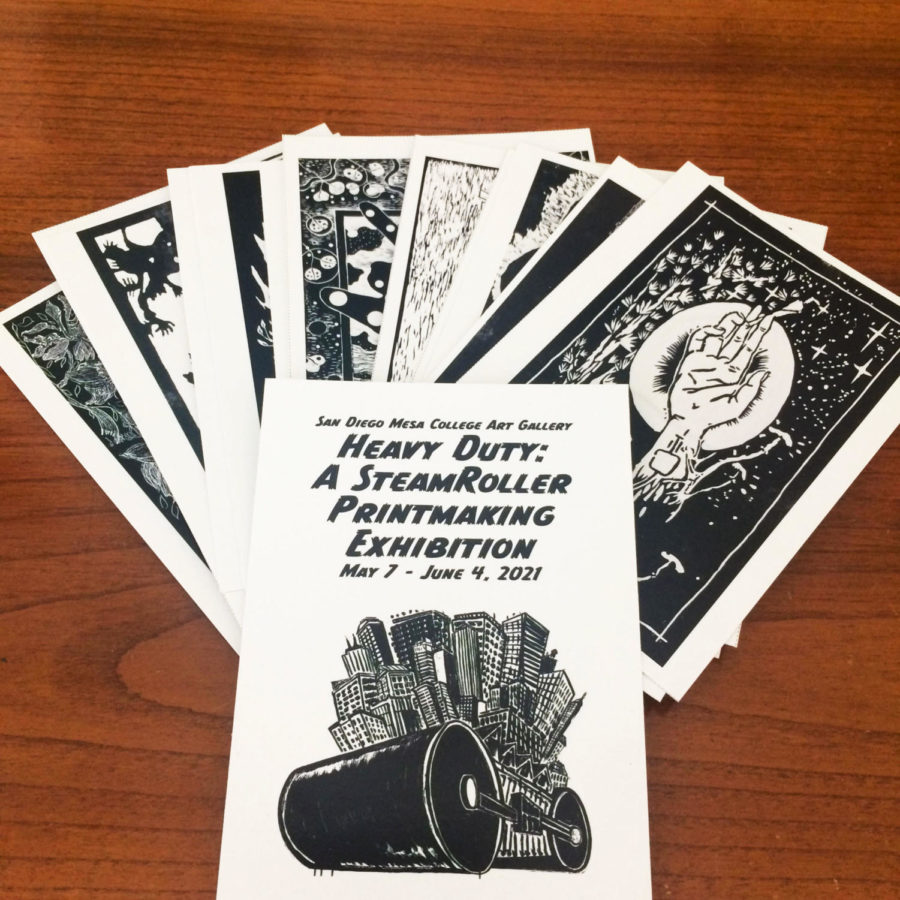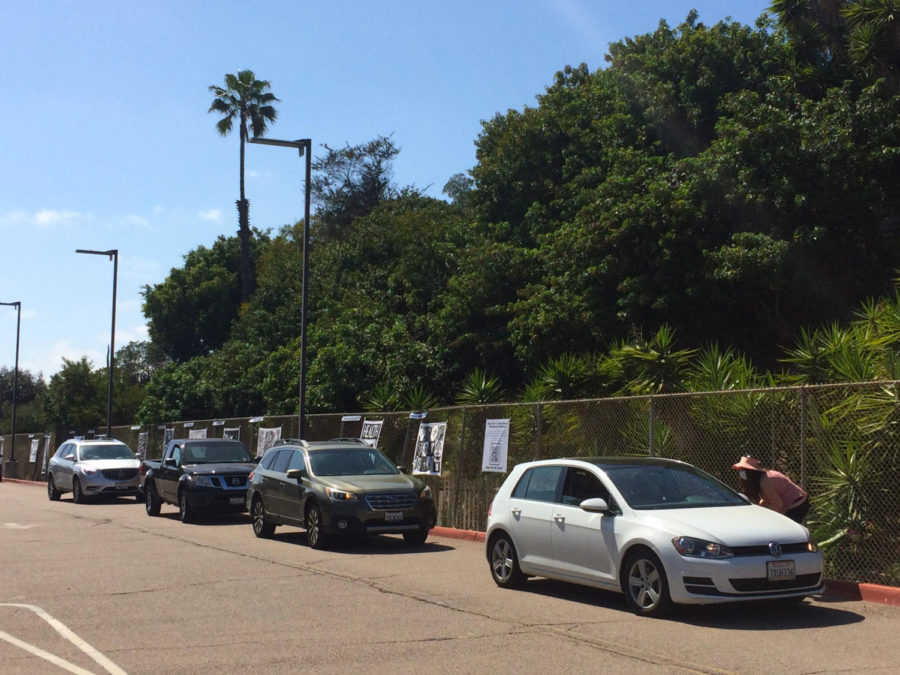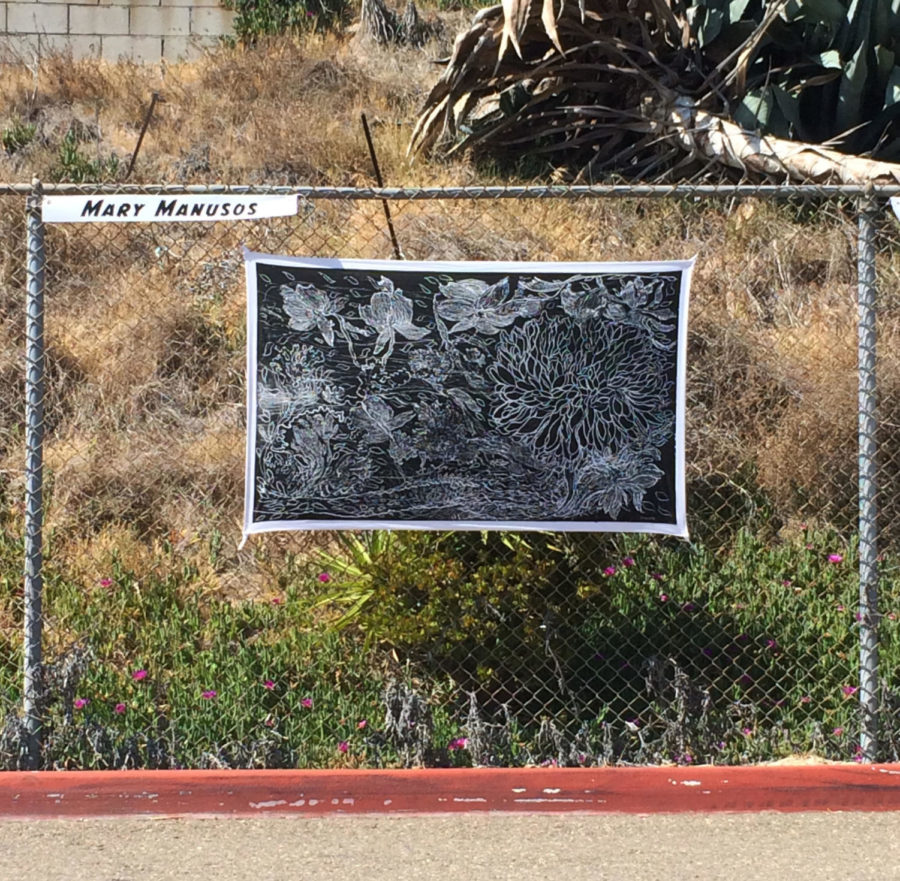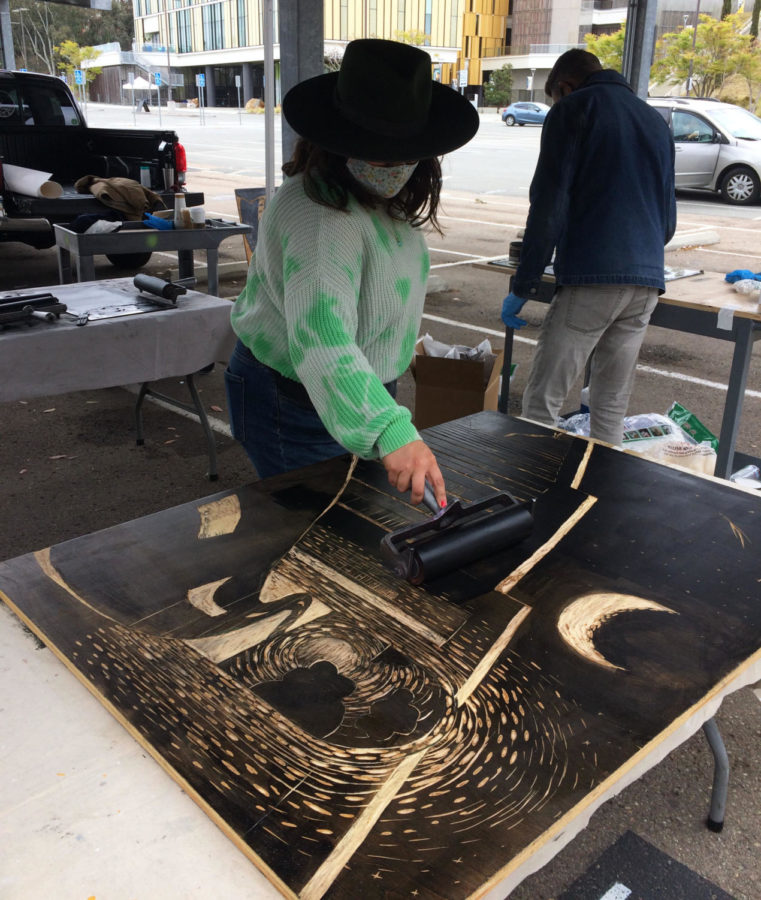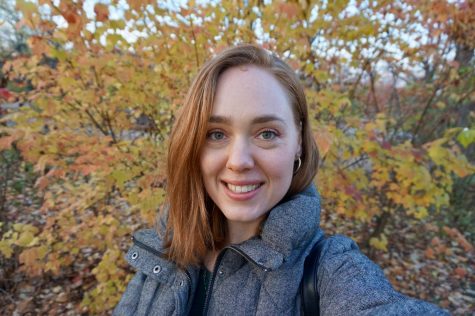A line of cars passed through a Mesa parking lot on May 7 as the Mesa Art Gallery opened their new show to the public. “Heavy Duty: A Steamroller Printmaking Exhibition” was conceived and orchestrated by Gallery Director Alessandra Moctezuma, whose passion for printmaking was evident in the fun twist she brought to the creative process.
Last fall, the art gallery pivoted under COVID-19 restrictions to successfully put on an outdoor, drive-thru art exhibit. This spring, Moctezuma said that she wanted “to do something in a similar vein that would safely engage students and the community,” but that would also add “another level of excitement to make it unique.”
An industrial-sized steamroller printing large-scale pieces of art in the parking lot certainly fits the bill.
For this exhibit, they used the steamroller to act as the pressure of a moving printing press. Moctezuma said that she learned about other colleges using this unique method to print and thought it was a great idea to anchor the new show. Chris Lahti, printmaker and owner of The East County Printshop, served as a guide for the ambitious project. He oversaw the technical aspects of working with the “press” as well as hosting two workshops over Zoom for students, staff and faculty at Mesa who were interested in learning about the art form.
“People want to work with things that are tangible,” Lahti said in an interview a couple of weeks before the event. “I think there is almost a mystery to working with materials. We are so accustomed to everything being digital and non-tangible that materials have their own seducing qualities to them and people are finding that interesting.”
Sixteen local artists were invited to participate in the exhibit. Using hand tools or power tools, they scraped, gouged and chiseled their 3’ x 5’ blocks of plywood into carved reliefs. Lahti estimated that some blocks took around nine hours to carve while other, more intricate pieces might have taken up to 60 hours. Professor Wendell Kling’s drawing class also contributed to the exhibit, working on smaller individual blocks that were then arranged into two printed pieces. Several of the artists, professional and student alike, took part in the steamroller printing process, which occurred over a couple of days on campus and was livestreamed on the gallery’s Facebook page on April 21.
Many expressed amazement at the unique process used to create the prints. “You got a steamroller?” a visitor named David Lipson asked Moctezuma. “How fun, I love the scaling up!” Others stated their admiration of the time and detail that went into each print as they chatted with gallery staff and expressed their interest in learning how to do printmaking themselves.
Lahti described an encounter where a young boy around the age of eight was peppering him with questions at the entrance to the exhibit. Lahti said that after making it clear that the boy could do a smaller version of this at home, the boy began excitedly repeating the names of the materials to his mother, eager to have a go at it.
Citlalli Hernandez, a student at Mesa, said that she would “definitely be interested” in printmaking classes if Mesa began to offer them again. “I like it because I did something similar back in middle school, but this is something that is on a much bigger scale,” she added. Her favorite work, she said, was an intricate floral print by artist Mary Manusos.
Manusos attended the drive-thru reception with a van packed full of family. When asked how long her piece took to make, she couldn’t quite count the hours but said that she kept coming back to it over and over for about two weeks until suddenly, she said, “that was it. It was done.”
Many of the prints in the exhibit represent themes that the artists are working on in other media. As such, they give insight not only into the process of printmaking but also as to how an array of artists with their own uniquely cultivated styles translate their messages through this particular medium. Art is created in the process of conceptualizing more art.
“I like to use geologic processes as metaphors for social dynamics and different elements,” said Trevor Amery. While staying at a friend’s cabin this past year, he said he found inspiration in the woods that surrounded him. “I fell in love with the sounds of the Aspens,” he added. As the lower limbs of the Aspen trees are shed, Amery explained, they create unique oval-shaped rings that look like eyes. “I loved the idea of listening to them and feeling them kind of looking back at me.”
Further down the chain-link fence, Morgan Miller III’s print is bold with a simple design and powerful lettering. “Health Care For All,” serves as more than just a statement piece, Miller explained. It is a prototype for a protest sign. “Since it’s going to be painted on fabric,” he said, “I figured it would be easy to roll it up and transport it, then roll it onto a frame.”
Katie Ruiz’s “Re-imagine Welcome,” is reflective of what she said is an increasing cross-border conversation around immigration and the focus of a new series she is developing. “This is the border,” Ruiz said while describing her print as she inked it up on April 21, “and there are these imaginary portals that come open up and you can go through the border–cross the border.” While she is best known for her colorful, vibrant and textured works, this black and white print still manages to capture and powerfully convey themes of connection, community and culture.
The artists showcased in this exhibit are: Mary Manusos, Trevor Amery, Morgan Miller III, Katie Ruiz, Jenny Armer, Jennifer Anne Bennett, Brian Gibson, Wendell Kling, Chris Lahti, Jim Melli, Yvette Roman, Sibyl Rubottom, Jose Hugo Sanchez, Katy Yeaw, Samantha and Ty Creighton, as well as 24 participating Mesa students.
Moctezuma credits Gallery Coordinator Jenny Armer with being the other half in their “dynamic duo,” taking exciting ideas for the gallery and making them come to life. Armer said that around 100 visitors attended the opening reception.
“It was really rewarding to see everyone so excited about the finished works,” Moctezuma said, including students, faculty, community members and higher-ups at Mesa. In speaking about the prospect of returning printmaking classes to Mesa, Moctezuma said, “I’m hoping that this will fuel them to offer those printmaking classes and get them excited to see that this is a viable, interesting and magical process.”
The drive-thru exhibit will be up until June 4. It is located in Mesa’s Parking Lot 1 and open to the public during the week from 10 a.m. to 4 p.m. You can find more information about the printing process, the images displayed, and the contributing artists here. You can also read our coverage of the printing process done in April.


